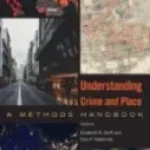Understanding Crime and Place: A Methods Handbook
 Author: Donovan X. Ramsey
Author: Donovan X. Ramsey
Publisher: One World, 2023. 448 pages.
Reviewer: Frederick T. Martens | September 2023
Living through the era “when crack was king,” I can personally attest to the human devastation that was visited upon communities of color in the mid-1980s. In charge of an undercover narcotics operation in the New York metropolitan area, purchasing crack was as easy as having a pizza delivered to your home. It was everywhere. Today, it has essentially been relegated to the dustbin of history. Donovan Ramsey captures both the moral panic that existed at the time and, more importantly, challenges the classic explanations of why it no longer poses a threat.
To many of my colleagues who believe enforcement was the primary or only reason for this profound result, Ramsey has provoked relevant issues that upend what are often self-serving rationales. Relying on empirical evidence acquired through a substantial number of interviews, he rightfully questions enforcement strategies that have essentially resulted in mass incarceration. Indeed, any credible discussion on the degree of racism which affected mass incarceration cannot ignore the obvious sentencing disparity between powder cocaine and crack.
Ramsey has demonstrated that a movement reflected in a relatively benign term, resiliency, is a silver bullet that can turn the tide of the drug war from that of a punitive and carceral approach to one that embraces harm reduction and compassionate and reformative sanctions.[1]
This theme rebounds throughout Ramsey’s findings as he traversed the underbelly of society, interviewing those who had succumbed to the attraction of crack as well as those who had front-row seats in the execution of the “war on drugs.”
Ramsey makes a compelling case for the mobilization of the larger community—hip-hop artists, Black filmmakers, rappers, and Dr. Dre—all playing a critical role in dissuading the use and abuse of crack.[2]
In many respects, Ramsey has triggered a needed discussion on how left to their own devices, the Black community has responded to this public health epidemic and emerged stronger. He has demonstrated that collectively, the Black community lacking the resources available to the white middle class crippled this disease by using the tools acquired by confronting decades of racism.
“The crack epidemic is over. We should celebrate that, and the fact that Black America survived it and the war on drugs that followed. People of good conscience should also hold to account the individuals and entities that helped spread the epidemic, and those that organized a draconian response merely for political gain,” Ramsey unapologetically concludes.[3]
Frederick T. Martens was in charge of a narcotics unit in the New Jersey State Police in the 1980s. He is also a former president of IASOC.
[1] Donovan X. Ramsey, When Crack was King: A People’s History of a Misunderstood Era 325-26 (2023) (arguing “…real community, as honest and old as strangers huddled together in bowels of ships, is what sustained Black America through the trials and tribulations of the crack epidemic”).
[2] Id. at 322-24.
[3] Id. at 367.


